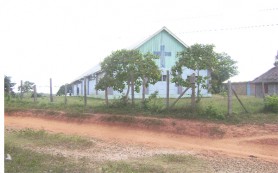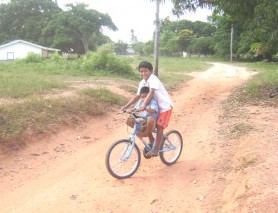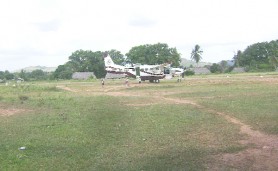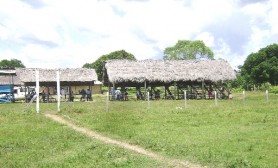Aishalton toshao says malaria up
It is almost the end of the rainy season in the Deep South Rupununi and there has scarcely been any rain. Malaria cases have increased and as they contemplate the pale, cloudless skies, residents are becoming increasingly worried.

“If this continues it will really have a very hard impact on the farmers and I’m worried about it because if it do, it will affect us tremendously”, said Hidebrand `Chris’ James, the Toshao of Aishalton- the largest village in the sub-district during a visit by Stabroek News to the region last week. With a population of mainly Wapishana Amerindians, who mostly depend on subsistence farming for their livelihood, the six villages that make up the ‘Deep South’ district of the Rupununi are contemplating hard times ahead, should the rains not arrive.
“I have never seen this in all my life”, James told this newspaper in Aishalton last week. He explained that during the 1997/98 El Nino, when there was a severe shortage of water, the phenomenon had occurred during the dry season. “What happened during that time, the rainy season had passed its course and just that it had extra sun during the dry season but when the rainy season came the other year, it fell according to how it supposed to fall”, he said. However, in the past few months- the normal rainy season in the Rupununi savannahs, there has scarcely been any rain.
Residents are becoming increasingly worried and a resident from Karaudarnau, 14 miles away from Aishalton told Stabroek News that there is hardly any cassava and the plants are drying up. Cassava is the key staple and is used to make farine. James blamed the weather pattern on climate change and said that if it continues and the situation worsens, immediate help will be sought.
Severe impact
Meanwhile, Minister of Agriculture Robert Persaud on Monday met with stakeholders to identify measures that can be put in place to reduce crop loss due to the dry conditions in Region Nine.
According to a Government Information Agency (GINA) press release Persaud discussed

adaptation and other measures. The current El Niño-like conditions prevailing countrywide have had a severe impact on agriculture.
GINA said the ministry has been working tirelessly to meet irrigation demands of Region Nine farmers as the extremely high temperatures marked by intense sunshine and brief showers have been detrimental to cassava cultivation. Persaud said while assessments are currently on-going, a technical team will be dispatched to the region to conduct further impact assessments. The team will also assist residents with mounting an appropriate response to counteract the effects of the dry season. The agriculture and Amerindian affairs
ministries are collaborating to address these concerns. Plans are in train to provide relief food supplies and source a strain of cassava sticks that can flourish under the prevailing conditions.
Clairmont Lye, Managing Director of Beacon Foundation, an organisation that works with farmers of the North Rupununi district, said from all indications farmers will be challenged to act swiftly and to increase planting of the staple to meet traditional as well as new market demands. The ministry said the impact of the season in Region Nine is severe thus it was agreed that intervention will first be directed there, followed by regions eight, seven and one as the emergency demands.

GINA said Head of the National Agricultural Research Institute, Dr Oudho Homenauth; Chief Crops and Livestock Officer, Brian Sears; Permanent Secretary and Deputy Permanent Secretary at the Amerindian Affairs ministry Nigel Dharamlall and George Jervis and Representative of the North Rupununi District Development Board, Sydney Allicock also attended the meeting.
Malaria
Residents told Stabroek News that the past months have seen an increase in malaria cases in the district. While no figures were immediately available some residents from Karaudarnau and another village, Achwib said that the prevalence of the disease has gone up in their villages. James said that as leader of his community, he is worried about the disease. “I want to see something being done to try to eliminate this malaria outbreak”, he said. He disclosed that in Aishalton, from January up the end of August, there had been over 150 cases of malaria compared to the same period last year, in which there were three cases. Luckily there have been no deaths so far this year. “I want the government or somebody to look into this”, he asserted.
It is not easy to get to the Region Nine (Upper Takutu/Upper Essequibo) community. One way is overland on the Linden-Lethem trail to the border community of Lethem-the administrative centre and largest community in Region Nine. Then persons utilize trucks, pick-ups, tractors, motorcycles, bicycles and even bullock carts on the 180km dusty, bumpy trail to Aishalton. Well-known tales abound about travails on the trail including getting struck for days in mud and the “breaking-down” of a vehicle. The infamous, collapsed Rupununi River Bridge at Katoonarib, built at a cost of $16M is a source of much discomfort to residents. After more than a year, it remains unfixed and useless. Reports indicate that a completely new bridge will have to be built and at a much greater cost.
From the mountain-encircled, gently rolling plains of the North Savannahs, life and the

road is rougher in the rugged, hilly, rocky South Savannahs. The ‘back road’ to Aishalton via the bridge at Karaudarnau, though a little less shorter; is much more difficult to traverse. Of particular concern is the “area of thick black mud” where countless vehicles have gotten stuck. Even in the dry season, the mud remains and persons have to disembark vehicles and navigate the mud on foot, as this reporter found out only too well. Toshao of Karaudarnau, Arnold Stephens had raised this as an issue of particular concern at a meeting in Aishalton last week, where he appealed to mining company, Romanex for assistance in fixing the piece of road.
Flocking to the Marudi Mountain
Life is changing in the Deep South Rupununi. Not much though, says Stephens and James. Miners have been flocking to the Marudi Mountain area and, according to some, show no respect to the village councils and others in the area. A Guyana Geology and Mines Commission (GGMC) official present at the meeting said that the agency has mandated that miners have to report to the toshao or council of the villages that they pass through and have urged them to show respect. Many residents want jobs but there are few. A few persons from his village had acquired jobs with Romanex, Stephens said. The proposed investment by the company- though there are a few concerns, is generally being looked at with approval by residents who welcome their “consultative” approach and the fact that the company seems to be more “organized” and “listens” to the people. Jobs and a possible market for produce are opportunities they await.
According to James, the villagers hope to have a fruitful relationship with the company, particularly in terms of a market for produce. Another area where they hope to gain is scholarships. The toshao explained that the performances of students have improved but parents do not have the finances to send them to the better schools and he envisages some support being provided.
The Aishalton Secondary School draws students from the six villages in the Deep South and some persons had said that the dormitories were overcrowded and were worried about space for the new batch of students for this school year. At the time, James said that he was not sure what the situation would be like when school re-opens but had noted that the buildings were deficient. “The building is not suited for humans…” he said explaining that the building was too low, it does not have a ceiling and in the type of weather that the area has been experiencing, by mid-day it is very hot. “It is very inhuman to have children learning in a school like that”, he declared.
Additionally, he expressed dissatisfaction with the rapid turnover of teachers, stating that this is not helping the students. “I feel that if they have one stable teacher they would know how to work with kids”. The village leader also voiced his displeasure with the last batch of volunteers from Project Trust, a British programme, which saw volunteers being assigned to teach there for a period. “I don’t think they are contributing anything better towards the kids”, he said. He added that there also seems to be an increase in drug use in the community with persons exhibiting certain behaviours. He stated that at the school there, someone was caught but there was no concrete evidence. “Hearing and finding is two different things”, he commented.
About 1,200 persons reside in Aishalton while about 8000 people live in the six Deep South Rupununi villages. People can get lost in the vast, sprawling area. Or the vehicle can break down halfway to Lethem and the only way to move would be to drive for a few metres until the engine stops, wait for it to “recover”, then move the next few metres. It is interesting – the sound of silence in the empty savannah, blue mountains in the distance. Wild cows and horses, savannah fires, “real” cowboys and endless stories of life in the Rupununi. A hardy people eke out a living in the South savannahs. They await one thing now: Rain.




